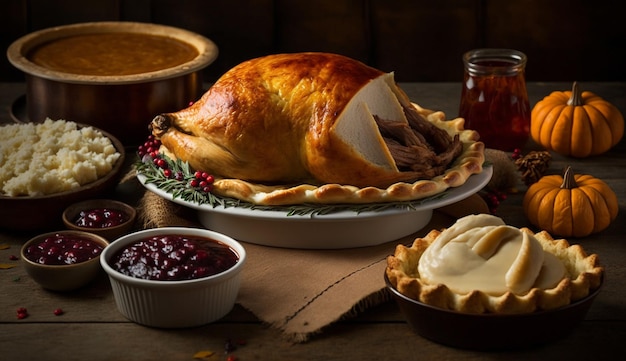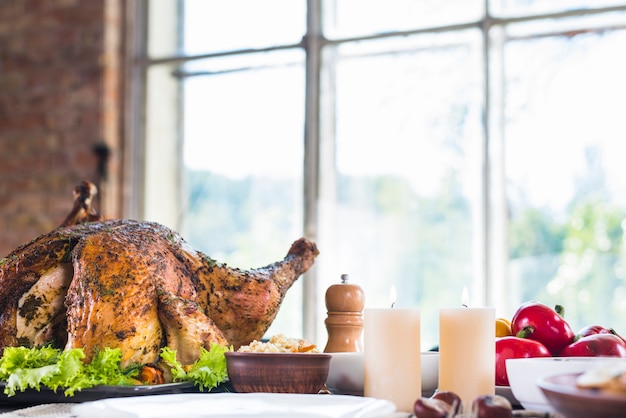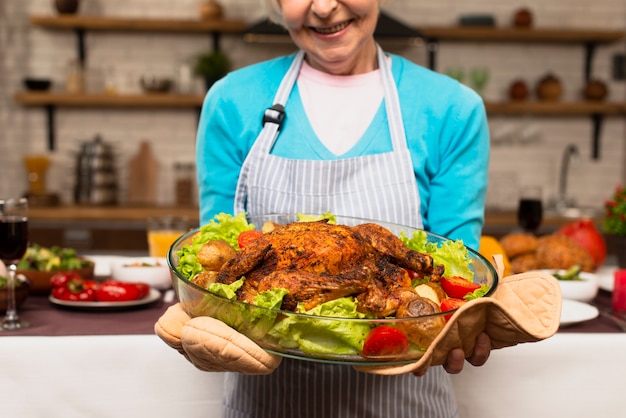Ah, the glorious stuffed turkey! It's the centerpiece of many festive gatherings, a symbol of tradition and good times. But let's be honest, mastering the art of the perfect roast turkey can be a bit daunting. That's where I come in. As someone who's been tasked with making the turkey for countless family feasts, I've learned a thing or two about what it takes to cook one that's not only delicious but also makes everyone sing your praises. So, grab a cuppa, settle in, and let's embark on a culinary adventure together!
(Part 1) The Turkey: A Look Under the Hood

The first step is getting to know your turkey – its size, weight, and condition. It's a bit like a pre-flight check for a culinary journey, ensuring everything's ready for takeoff.
Choosing the Right Turkey
First, give your turkey a good once-over. Make sure there's no funky smell or discoloration, and then, the big one – check its weight! That's your key to figuring out cooking times. Don't worry, we'll dive into those later. I always recommend a fresh turkey over frozen, but if you're working with a frozen one, make sure you follow the instructions for safe thawing – we don't want any surprises!
Brining: A Secret Weapon for Tenderness
Now, this is where I like to add a bit of magic to my turkey – brining. Yes, I know it sounds fancy, but it's really simple and makes a HUGE difference. Basically, you soak the turkey in a salty solution for a few hours (or even overnight). This helps the turkey retain moisture, ensuring a beautifully tender and juicy result. You can buy ready-made brines or whip up your own with salt, water, herbs, and spices – it's like a spa treatment for your turkey!
For those who are new to brining, it's a great way to infuse the turkey with extra flavour. Imagine your turkey smelling divine before it even goes into the oven! It's a real game changer, especially for those who prefer a more succulent texture.
Stuffing: To Stuff or Not to Stuff?
Here's a question that often pops up – to stuff or not to stuff? There's no right or wrong answer. It depends on your personal preference and what you feel like cooking. I'm a big fan of stuffing, because it adds another layer of flavour and brings a warm, comforting vibe to the meal. But, it's important to remember that stuffed turkeys need to cook longer than unstuffed ones. The stuffing acts as a bit of a heat insulator, so you'll need to adjust your cooking time accordingly.
If you're feeling adventurous with the stuffing, you can experiment with different flavours. I've tried everything from classic bread stuffing to wild rice and cranberry combos – the possibilities are endless! Just remember to always cook the stuffing separately if you’re stuffing the turkey. This ensures it’s cooked thoroughly and prevents any potential food safety issues.
The Art of Checking Doneness
Alright, now that we've got the turkey prepped, it's time to talk about how to tell if it's actually cooked. No guessing allowed here, folks! We're talking science, and it involves a trusty meat thermometer.
Make sure that internal temperature reaches at least 165°F (74°C) in the thickest part of the thigh, without touching the bone. If you're unsure, you can also check the juices running from the thigh. They should be clear, not pink. Finally, if you gently jiggle the turkey, it should feel firm – no wobbling allowed!
(Part 2) Stuffing: A Culinary Adventure

Now, let's talk about the star of the show for many – the stuffing! This is your chance to unleash your inner culinary artist and get creative. It's like a blank canvas for flavor combinations.
Choosing Your Stuffing Base
I personally gravitate towards classic bread stuffing. It's comforting, familiar, and a timeless classic. But hey, don't be afraid to experiment! You can use a variety of grains like rice, quinoa, or even wild rice.
A World of Flavour Combinations
The fun part about stuffing is that you can add a symphony of herbs and spices. Thyme, rosemary, sage, and even a bit of citrus zest can transform a basic stuffing into a flavour explosion! Remember, the key is to find a flavour profile that suits your taste buds.
A Little Tip for Perfect Stuffing
Here's a little secret: don't stuff the turkey too tightly. Give it a bit of breathing room so it can cook evenly. You want fluffy and flavorful, not dense and dry. It's also a good idea to stuff the turkey right before you pop it into the oven. This helps prevent the stuffing from getting soggy.
(Part 3) The Big Day: Oven Time!

Now we're getting to the fun part – roasting the turkey! It's time to get that oven fired up and ready for culinary action. But before we dive into the heat, let's take a moment to prep the turkey for oven glory.
Prepping the Turkey
Start by patting the turkey dry with paper towels. This helps the skin crisp up beautifully – we want that golden-brown perfection, right? Next, season your turkey with salt, pepper, and your favourite herbs and spices. I like to use a good quality poultry seasoning, but you can go wild with a mix of herbs and spices to create your own signature flavour.
Roasting Rack: A Must-Have for Even Cooking
Now, if you're stuffing the turkey, pop the stuffing inside before placing it in the oven. If you're not stuffing, you're good to go. Either way, the next step is a roasting rack. This little guy is essential for ensuring even cooking by allowing air to circulate around the turkey.
Finding the Right Oven Temperature
The oven temperature depends on the size of your turkey. For a smaller turkey (10-12 pounds), aim for 325°F (165°C). For a larger turkey (12-14 pounds and above), go for a slightly lower temperature of 300°F (150°C) to prevent it from drying out.
Cooking Time: A Guide to Turkey Time
Here's a general guide for cooking times for unstuffed turkeys. Remember, stuffed turkeys will need an extra 30 minutes:
| turkey weight | Cooking Time |
|---|---|
| 10-12 pounds | 3-3.5 hours |
| 12-14 pounds | 3.5-4 hours |
| 14-16 pounds | 4-4.5 hours |
| 16-18 pounds | 4.5-5 hours |
| 18-20 pounds | 5-5.5 hours |
Always check the internal temperature of your turkey with a meat thermometer – that's your golden rule! Remember, 165°F (74°C) in the thickest part of the thigh is the target.
Basting: A Touch of Moisture Magic
Now, here's a tip that will make your turkey even more succulent: basting. You'll want to baste your turkey every 30 minutes or so with the pan drippings or broth. It's a simple step, but it helps keep the turkey moist and flavorful. Use a turkey baster to evenly distribute those delicious juices.
Resting: The Secret to Juiciness
Once your turkey is cooked, let it rest for 15-20 minutes before carving. This gives the juices time to redistribute, resulting in a much juicier and tastier turkey. I know it's tempting to carve right away, but trust me, it's worth the wait!
(Part 4) The Ultimate turkey gravy: A Culinary Triumph
And now, for the grand finale – gravy! A perfect gravy is a symphony of flavors, smooth and rich, that elevates your turkey feast to new heights.
Making Gravy from Scratch
You can create a truly delicious gravy from scratch using the turkey drippings. First, pour off the fat from the roasting pan and set it aside. Then, add a cup or two of broth or water to the pan and scrape up any browned bits from the bottom. This adds a depth of flavor to your gravy. Bring the mixture to a boil, then reduce the heat and simmer for a few minutes.
Now, the secret to a perfect gravy is thickening. Enter the slurry! Simply mix cornstarch and cold water, then whisk it gradually into the simmering gravy until it reaches your desired consistency. Taste the gravy and adjust seasoning as needed.
A Cheat's Guide to Gravy
If you're short on time or prefer a simpler approach, there are plenty of good-quality gravy mixes available. Just follow the package instructions and you'll have a tasty gravy in minutes.
But, even if you're using a mix, you can still add your own flair. A little fresh rosemary or thyme can elevate the flavour. Just add them to the gravy in the last few minutes of cooking.
Serving Your Gravy with Pride
Serve your gravy hot, over the turkey, mashed potatoes, stuffing, or anything else you desire! It's the perfect companion for all the flavors of your holiday feast. And, if you have any leftover, don't throw it away! It's fantastic for topping leftover turkey sandwiches or creating a delicious pot pie.
(Part 5) Leftover Turkey: A Feast for Days
Leftover turkey! A culinary bonus after a successful roast. Don't just think of it as leftovers, think of it as a chance for more culinary adventures.
Turkey Sandwiches: A Classic Comfort
One of the easiest ways to use up leftover turkey is a good old-fashioned sandwich. You can keep it classic with turkey and cranberry, or get creative with avocado, bacon, spicy chili sauce, or any other toppings that tickle your fancy. I always like to add a bit of mayonnaise and mustard for a tangy kick.
turkey salad: A Light and Delicious Option
Turkey salad is a lighter and just as satisfying way to enjoy leftover turkey. You can make a classic version with mayonnaise, celery, onion, and cranberries, or add your own personal touch with grapes, walnuts, or a bit of Dijon mustard for extra zip.
turkey soup: A Hearty and Soul-Warming Treat
For a warm and comforting meal, nothing beats a good turkey soup. Combine leftover turkey with vegetables like carrots, celery, and onions. You can even add some leftover stuffing or gravy for extra flavour. The possibilities are endless!
turkey pot pie: A Savory and Comforting Dish
For a dish that's both savory and comforting, a turkey pot pie is a winner. Combine leftover turkey, vegetables, and gravy in a pie crust. You can use store-bought or make your own – either way, it's a surefire crowd-pleaser.
(Part 6) Timing is Everything: Planning for Success
Planning is key to a stress-free turkey day. We want you enjoying the festive atmosphere, not panicking in the kitchen!
A Timeline for Turkey Day
Here's a general timeline to help you visualize the process. It's not set in stone, but it gives you a great starting point:
- Day Before: Brine the turkey if you're doing it, prep the stuffing, make the gravy base (if you're not using a mix), and chill everything. This sets you up for a smoother day-of experience.
- Morning of: Get the turkey out of the fridge about an hour before you plan to cook it, to let it come to room temperature for even cooking. Prepare any sides like mashed potatoes, gravy, and cranberry sauce. While those cook, get your oven preheated.
- Afternoon: It's turkey time! Pop that bird in the oven and let it work its magic. While it's cooking, prepare any other dishes that need attention. Put on some music, a podcast, or just relax and enjoy the process!
- Evening: Your turkey should be ready! Rest the bird, carve it, and get those delicious sides ready to serve.
Tips for a Stress-Free Turkey Day
Here are a few extra tips to make your turkey day a success:
- Delegate: If you're having guests, don't hesitate to ask them to bring a dish or two. It'll lighten the load and make everyone feel involved.
- Prep Ahead: Anything you can do the day before, do it! This will make the day of the feast much smoother.
- Enjoy the Process: Take your time, relax, and savor the moment. It's about creating memories, not just making a meal.
(Part 7) Troubleshooting: When Things Go Awry
We all have those moments in the kitchen where things don't go exactly to plan. But don't worry, I've got your back!
Turkey Troubles: Common Issues and Solutions
Here are some common turkey-related issues and how to tackle them:
- Turkey's too dry: If your turkey ends up a bit dry, don't panic! You can add a bit of broth or water to the roasting pan to create steam and help re-moisturize the bird. Basting frequently also helps. You can also add a bit of butter or oil to the skin before roasting, which will help to keep it crispy.
- Turkey's not cooked through: If the turkey hasn't reached the desired internal temperature, just continue cooking it until it does. Check the temperature with a meat thermometer every 15-20 minutes.
- Stuffing's too dry: If your stuffing ends up too dry, you can add a bit of broth or water to it. You can also add some chopped vegetables like carrots or celery for moisture and flavor.
- Gravy's too thin: If your gravy is too thin, you can thicken it with a slurry, which is a mixture of cornstarch and cold water. Simply whisk the slurry into the simmering gravy until it reaches your desired consistency.
- Gravy's too thick: If the gravy is too thick, you can thin it out with a little bit of broth or water. You can also whisk in a little bit of butter to help emulsify the gravy and make it smoother.
Don't Panic!
Remember, cooking is all about experimenting and learning. Don't be afraid to make mistakes. Even the most experienced cooks have their off days. The most important thing is to enjoy the process and have fun! If things don't go exactly as planned, just roll with it, and remember, there's always next year.
(Part 8) FAQs: Your Turkey Questions Answered
I know you have questions about turkey. It's a big event! So, here are some common questions, and my answers based on years of experience.
1. What's the best way to thaw a frozen turkey?
The safest and most recommended way to thaw a frozen turkey is in the refrigerator. It takes about 24 hours for every 5 pounds of turkey to thaw. For example, a 15-pound turkey will take about 72 hours to thaw. You can also thaw a turkey in cold water. But make sure the turkey is completely submerged and change the water every 30 minutes. This method takes about 30 minutes per pound to thaw.
2. Can I stuff the turkey the day before?
It's not recommended to stuff the turkey the day before. This is because stuffing needs to be cooked thoroughly to prevent foodborne illness. If you stuff the turkey the day before, it won't have enough time to cook through properly. It's better to stuff the turkey right before you roast it.
3. How do I know if my turkey is cooked?
The best way to know if your turkey is cooked through is to use a meat thermometer. It should reach an internal temperature of 165°F (74°C) in the thickest part of the thigh, without touching any bone. You can also check the juices. They should run clear, not pink.
4. How do I keep my turkey moist?
There are a few things you can do to help keep your turkey moist. First, brine it for a few hours or overnight. Second, baste the turkey every 30 minutes or so with pan drippings or broth. Third, let the turkey rest for 15-20 minutes after it's cooked. This will allow the juices to redistribute, resulting in a juicier and more flavorful turkey.
5. What can I do with leftover turkey?
You can make all sorts of things with leftover turkey! It’s a versatile ingredient. Some popular options include turkey sandwiches, turkey salad, turkey soup, turkey pot pie, and turkey tacos. You can also freeze leftover turkey for later use. Just let it cool completely before freezing.
Final Thoughts
There you have it! A comprehensive guide to roasting the perfect turkey, from choosing the right bird to making the most of your leftovers. Remember, with a bit of planning, a dash of confidence, and a whole lot of love, you can create a turkey that's truly memorable. Happy feasting!
Everyone is watching

How to Cook Frozen Lobster Tails Perfectly: A Step-by-Step Guide
RecipesLobster. Just the word conjures up images of lavish meals, special occasions, and a taste of luxury. But let's...

Pigs in a Blanket Cooking Time: How Long to Bake for Perfect Results
RecipesAh, pigs in a blanket. Just the name conjures up images of those delightful little parcels of crispy pastry en...

Pork Fillet Cooking Time: How Long to Cook It Perfectly
RecipesPork fillet, or tenderloin as it's sometimes called, is a real favourite in our house. It's so versatile, and...

The Ultimate Guide to Tender, Juicy Pulled Pork
RecipesRight, let's talk pulled pork. It's one of those dishes that just screams "comfort food," doesn't it? I mean...

The Ultimate Guide to Cooking Sweet Potatoes: From Roasting to Mashing
RecipesSweet potatoes. Just the name conjures up images of warm, comforting dishes, bursts of vibrant color, and a to...
